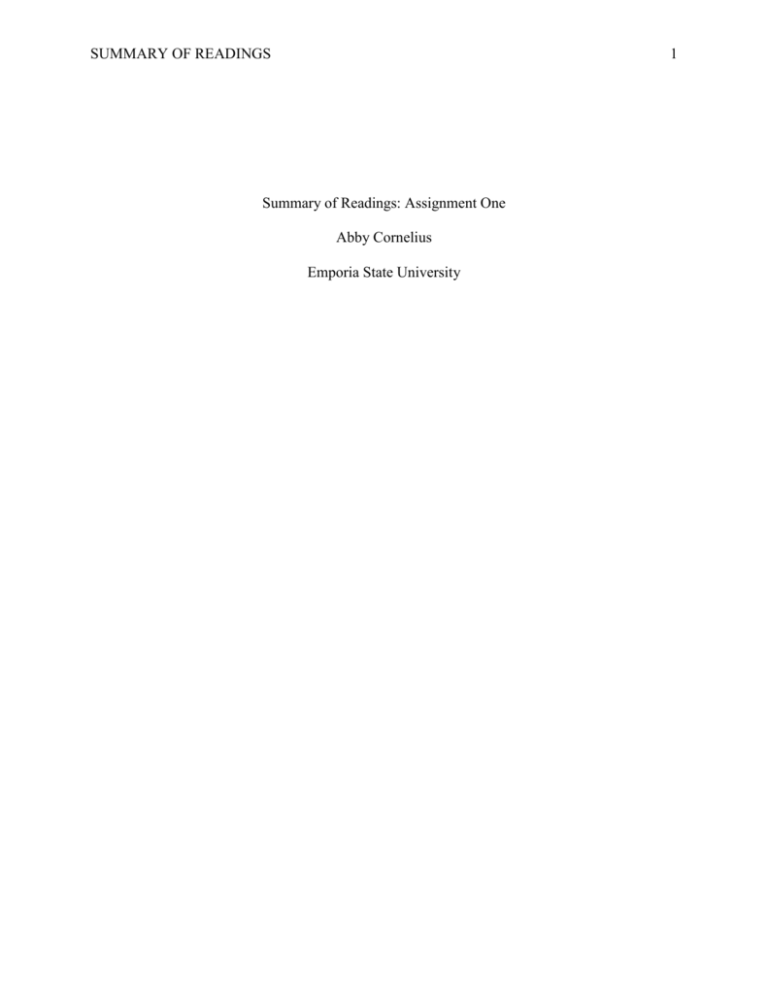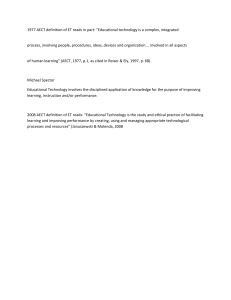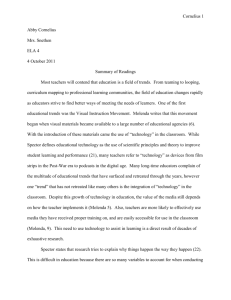Example APA paper
advertisement

SUMMARY OF READINGS 1 Summary of Readings: Assignment One Abby Cornelius Emporia State University SUMMARY OF READINGS 2 Summary of Readings Most teachers will contend that education is a field of trends. From teaming to looping, curriculum mapping to professional learning communities, the field of education changes rapidly as educators strive to find better ways of meeting the needs of learners. One of the first educational trends was the Visual Instruction Movement. Molenda (2007) writes that this movement began when visual materials became available to a large number of educational agencies (p. 6). With the introduction of these materials came the use of “technology” in the classroom. While Spector (2007) defines educational technology as the use of scientific principles and theory to improve student learning and performance (p. 21), many teachers refer to “technology” as devices from film strips in the Post-War era to podcasts in the digital age. Many long-time educators complain of the multitude of educational trends that have surfaced and retreated through the years, however one “trend” that has not retreated like many others is the integration of “technology” in the classroom. Despite this growth of technology in education, the value of the media still depends on how the teacher implements it (Molenda, 2007, p. 5). Also, teachers are more likely to effectively use media they have received proper training on, and are easily accessible for use in the classroom (Molenda, 2007, p.9). This need to use technology to assist in learning is a direct result of decades of exhaustive research. Spector (2007) states that research tries to explain why things happen the way they happen (p. 22). This is difficult in education because there are so many variables to account for when conducting educational research. Educational technologists try to improve learning and performance by creating educational strategies and then testing their effectiveness while battling a myriad of variables (Spector, 2007, p. 22). To account for these variables, specific instructional design models have been created to fit particular learning outcomes (Spector, 2007, SUMMARY OF READINGS 3 p. 25). Learning outcomes or “learning targets” are established as curriculum writers attempt to intersect the needs of instructors to teach the material, with the needs of learners to experience the targets in a meaningful way. The needs of learners play a much larger role theoretically than many educators spend time thinking about. Two pillars of learners needs are psychology and communication or more simply, “what people do and what people say” (Spector, 2007, p. 23). Educational technologists combine these two pillars with a third pillar that contains “humility and openness” (Spector, 2007, p. 23) to create innovative instructional models for learners. Instructional models are designed with instructional theory as a foundation. Instructional theory is based on learning theory which provides a link between how learning happens and how to aid the learning process (Schuh & Barab, 2007, p. 76). From a wider scope, learning theory is founded on ontology and epistemology. These ideas allow educational technologists to define what is real and how that knowledge is gained (Schuh & Barab, 2007, p. 70). With this focus, Burton, Moore, and Magliaro (2004) claim that behaviorism accounts for most learning (p. 10). The idea that individual’s actions and decisions are the basis for the individual's learning is an accepted tenet among educators. Teachers everywhere work together to create databases of lesson plans and instructional strategies to improve student achievement. ERIC, the U. S. Department of Education, and the Educational Research Service all work to promote learning through researched and proven methods. While many trends have passed through the history of education, two ideas stand out as focal points: “technology” will continually be integrated throughout curricula, and instructional models will continue to promote the use of educational technology in furthering student performance. SUMMARY OF READINGS 4 References Burton, J. K., Moore, D. M., & Magliaro, S. G. (2004). Behaviorism and instructional technology. [Electronic version]. Handbook of research for educational communications and technology (2nd ed.), 3-36. Retrieved from Association for Educational Communications and Technology: http://www.aect.org. Molenda, M. (2007). Historical foundations. [Electronic version]. Handbook of research for educational communications and technology (3rd ed.), 3-20. Retrieved from Association for Educational Communications and Technology: http://www.aect.org. Schuh, K. L., & Barab, S. A. (2007). Philosophical perspectives. [Electronic version]. Handbook of research for educational communications and technology (3rd ed.), 67-82. Retrieved from Association for Educational Communications and Technology: http://www.aect.org. Spector, J. M. (2007). Theoretical foundations. [Electronic version]. Handbook of research for educational communications and technology (3rd ed.), 21-28. Retrieved from Association for Educational Communications and Technology: http://www.aect.org.







